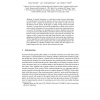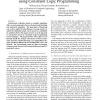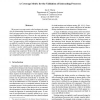ASPDAC
2012
ACM
13 years 1 months ago
2012
ACM
—In both pre-silicon and post-silicon validation, the detection of design errors requires both stimulus capable of activating the errors and checkers capable of detecting the beh...
CHARME
2003
Springer
14 years 9 months ago
2003
Springer
In formal verification, we verify that a system is correct with respect to a specification. Even when the system is proven to be correct, there is still a question of how complete ...
ATVA
2006
Springer
14 years 9 months ago
2006
Springer
Abstract. Since testing is inherently incomplete, test selection is of vital importance. Coverage measures evaluate the quality of a test suite and help the tester select test case...
TACAS
2001
Springer
14 years 10 months ago
2001
Springer
In formal verification, we verify that a system is correct with respect to a specification. Even when the system is proven to be correct, there is still a question of how complet...
IFIP
2001
Springer
14 years 10 months ago
2001
Springer
— Semi-formal verification based on symbolic simulation offers a good compromise between formal model checking and numerical simulation. The generation of functional test vector...
CAV
2001
Springer
14 years 10 months ago
2001
Springer
In formal verification, we verify that a system is correct with respect to a specification. When verification succeeds and the system is proven to be correct, there is still a q...
ASPDAC
2006
ACM
14 years 11 months ago
2006
ACM
— Lack of complete formal specification is one of the major obstacles for the deployment of model checking. Coverage estimation addresses this issue by revealing the unverified...
DATE
2006
IEEE
14 years 11 months ago
2006
IEEE
We present a coverage metric which evaluates the testing of a set of interacting concurrent processes. Existing behavioral coverage metrics focus almost exclusively on the testing...
DAC
2008
ACM
15 years 6 months ago
2008
ACM
Extensive software-based simulation continues to be the mainstream methodology for functional verification of designs. To optimize the use of limited simulation resources, coverag...





